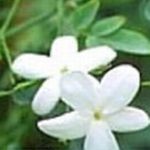| Common Name: |
Catalonian Jasmine |
| Other Names: |
Royal Jasmine, Spanish Jasmine, Jati |
| Botanical Name: |
Jasminum grandiflorum |
| Genus: |
Jasminum |
| Family: |
Oleaceae |
| Native Location: |
India (NW Himalayas) |
| Cultivation: |
Rich, well-drained soil in sun. Thin out shoots or cut back after flowering. Plants under cover may be affected by spider mite, aphids, whitefly, and mealy bugs. |
| Propagation: |
By semi-ripe cuttings in summer; by layering in autumn. Jasminum sambac "Grand Duke of Tuscany" is difficult from cuttings. |
| Harvest: |
Roots are lifted in autumn and dried for use in decoctions (J. sambac). Leaves are picked as required and used fresh or dried. Flowers are picked soon after opening each morning and used fresh for oil extraction, or dried for infusions, medicated oil, pastes and powders. |
| Height: |
5m (15ft) |
| Hardiness: |
Min. 7°C (45°F) |
| Parts Used: |
Leaves, flowers, oil. |
| Properties: |
A bitter, astringent, cooling herb that calms the nerves, checks bleeding, and stimulated the uterus. Regarded as an aphrodisiac for women and an alterative reputedly effective against various cancers and bacterial and viral infections. |
| Medicinal Uses: |
Internally, mainly in Ayurvedic medicine, for infectious illnesses with high fever, sunstroke, conjunctivitis, dermatitis, cancer (especially Hodgkin's disease, and cancers of the bone, lymph nodes, and breast), emotional upsets, and headaches. Often combined with Santalum album (See, Indian Sandalwood). Internally and externally for mouth ulcers (leaves). Externally for corns (leaf juice). |
| Culinary Uses: |
Flowers are used to scent China tea. |
| Economic Uses: |
Essential oil is used in the perfumery industry. |
| Bibliography: |
Encylopedia of Herbs by Deni Brown Copyright ©: 1995, 2001 Dorling Kindersley Limited pg 245
|

